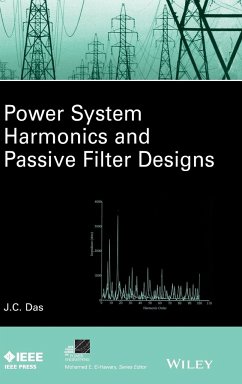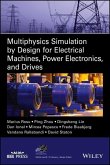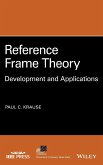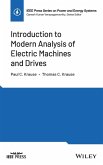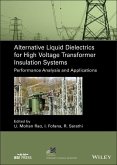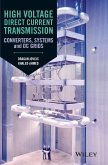J. C. Das
Power System Harmonics and Passive Filter Designs
J. C. Das
Power System Harmonics and Passive Filter Designs
- Gebundenes Buch
- Merkliste
- Auf die Merkliste
- Bewerten Bewerten
- Teilen
- Produkt teilen
- Produkterinnerung
- Produkterinnerung
As new technologies are created and advances are made with the ongoing research efforts, power system harmonics has become a subject of great interest. The author presents these nuances with real-life case studies, comprehensive models of power system components for harmonics, and EMTP simulations.
Comprehensive coverage of power system harmonics Presents new harmonic mitigation technologies In-depth analysis of the effects of harmonics Foreword written by Dr. Jean Mahseredijan, world renowned authority on simulations of electromagnetic transients and harmonics
Andere Kunden interessierten sich auch für
![Multiphysics Simulation by Design for Electrical Machines, Power Electronics and Drives Multiphysics Simulation by Design for Electrical Machines, Power Electronics and Drives]() Marius RosuMultiphysics Simulation by Design for Electrical Machines, Power Electronics and Drives165,99 €
Marius RosuMultiphysics Simulation by Design for Electrical Machines, Power Electronics and Drives165,99 €![Reference Frame Theory Reference Frame Theory]() Paul C. KrauseReference Frame Theory137,99 €
Paul C. KrauseReference Frame Theory137,99 €![Introduction to Modern Analysis of Electric Machines and Drives Introduction to Modern Analysis of Electric Machines and Drives]() Paul C. KrauseIntroduction to Modern Analysis of Electric Machines and Drives131,99 €
Paul C. KrauseIntroduction to Modern Analysis of Electric Machines and Drives131,99 €![Alternative Liquid Dielectrics for High Voltage Transformer Insulation Systems Alternative Liquid Dielectrics for High Voltage Transformer Insulation Systems]() Alternative Liquid Dielectrics for High Voltage Transformer Insulation Systems157,99 €
Alternative Liquid Dielectrics for High Voltage Transformer Insulation Systems157,99 €![Distributed Fiber Optic Sensing and Dynamic Rating of Power Cables Distributed Fiber Optic Sensing and Dynamic Rating of Power Cables]() Sudhakar CherukupalliDistributed Fiber Optic Sensing and Dynamic Rating of Power Cables152,99 €
Sudhakar CherukupalliDistributed Fiber Optic Sensing and Dynamic Rating of Power Cables152,99 €![High Voltage Direct Current Transmission High Voltage Direct Current Transmission]() Dragan JovcicHigh Voltage Direct Current Transmission128,99 €
Dragan JovcicHigh Voltage Direct Current Transmission128,99 €![Optimal Coordination of Power Protective Devices with Illustrative Examples Optimal Coordination of Power Protective Devices with Illustrative Examples]() Ali R. Al-RoomiOptimal Coordination of Power Protective Devices with Illustrative Examples153,99 €
Ali R. Al-RoomiOptimal Coordination of Power Protective Devices with Illustrative Examples153,99 €-
-
-
As new technologies are created and advances are made with the ongoing research efforts, power system harmonics has become a subject of great interest. The author presents these nuances with real-life case studies, comprehensive models of power system components for harmonics, and EMTP simulations.
Comprehensive coverage of power system harmonics
Presents new harmonic mitigation technologies
In-depth analysis of the effects of harmonics
Foreword written by Dr. Jean Mahseredijan, world renowned authority on simulations of electromagnetic transients and harmonics
Hinweis: Dieser Artikel kann nur an eine deutsche Lieferadresse ausgeliefert werden.
Comprehensive coverage of power system harmonics
Presents new harmonic mitigation technologies
In-depth analysis of the effects of harmonics
Foreword written by Dr. Jean Mahseredijan, world renowned authority on simulations of electromagnetic transients and harmonics
Hinweis: Dieser Artikel kann nur an eine deutsche Lieferadresse ausgeliefert werden.
Produktdetails
- Produktdetails
- IEEE Press Series on Power Engineering
- Verlag: Wiley & Sons
- 1. Auflage
- Seitenzahl: 872
- Erscheinungstermin: 23. März 2015
- Englisch
- Abmessung: 240mm x 161mm x 51mm
- Gewicht: 1458g
- ISBN-13: 9781118861622
- ISBN-10: 1118861620
- Artikelnr.: 40699289
- Herstellerkennzeichnung
- Libri GmbH
- Europaallee 1
- 36244 Bad Hersfeld
- gpsr@libri.de
- IEEE Press Series on Power Engineering
- Verlag: Wiley & Sons
- 1. Auflage
- Seitenzahl: 872
- Erscheinungstermin: 23. März 2015
- Englisch
- Abmessung: 240mm x 161mm x 51mm
- Gewicht: 1458g
- ISBN-13: 9781118861622
- ISBN-10: 1118861620
- Artikelnr.: 40699289
- Herstellerkennzeichnung
- Libri GmbH
- Europaallee 1
- 36244 Bad Hersfeld
- gpsr@libri.de
J.C. Das is a consultant of electrical power systems at Power Systems Studies, Inc., USA. He is Life Fellow of IEEE (UK), Fellow of IET (India), and has authored approximately sixty technical papers and published 190 study reports of real-world power systems. He is the author of three books including ARC Flash Hazard Analysis and Mitigation. He is a registered P.E. in the states of Georgia and Oklahoma, C.Eng. in UK, and Eur Ing in Europe. J. C. Das is also a member of CIGRE, Federation of European Engineers, and other technical associations and organizations.
FOREWORD xv
PREFACE xix
ABOUT THE AUTHOR xxi
CHAPTER 1 POWER SYSTEM HARMONICS 1
1.1 Nonlinear Loads 2
1.2 Increases in Nonlinear Loads 3
1.3 Effects of Harmonics 4
1.4 Distorted Waveforms 4
1.5 Harmonics and Sequence Components 7
1.6 Harmonic Indices 9
1.7 Power Factor, Distortion Factor, and Total Power Factor 11
1.8 Power Theories 13
1.9 Amplification and Attenuation of Harmonics 27
References 28
CHAPTER 2 FOURIER ANALYSIS 31
2.1 Periodic Functions 31
2.2 Orthogonal Functions 31
2.3 Fourier Series and Coefficients 33
2.4 Odd Symmetry 35
2.5 Even Symmetry 36
2.6 Half-Wave Symmetry 37
2.7 Harmonic Spectrum 41
2.8 Complex form of Fourier Series 41
2.9 Fourier Transform 43
2.10 Dirichlet Conditions 52
2.11 Power Spectrum of a Function 54
2.12 Convolution 56
2.13 Sampled Waveform: Discrete Fourier Transform 57
2.14 Fast Fourier Transform 64
References 69
CHAPTER 3 HARMONIC GENERATION-1 71
3.1 Harmonics in Transformers 71
3.2 Energization of a Transformer 79
3.3 Delta Windings of Three-Phase Transformers 82
3.4 Harmonics in Rotating Machine Windings 92
3.5 Cogging and Crawling of Induction Motors 97
3.6 Synchronous Generators 102
3.7 Saturation of Current Transformers 104
3.8 Ferroresonance 105
3.9 Power Capacitors 111
3.10 Transmission Lines 112
References 112
CHAPTER 4 HARMONIC GENERATION-II 115
4.1 Static Power Converters 115
4.2 Single-Phase Bridge Circuit 115
4.3 Reactive Power Requirements of Converters 122
4.4 Three-Phase Bridge Circuit 124
4.5 Harmonics on Output (DC) Side 133
4.6 Inverter Operation 135
4.7 Diode Bridge Converters 139
4.8 Switch-Mode Power (SMP) Supplies 142
4.9 Home Appliances 143
4.10 Arc Furnaces 144
4.11 Cycloconverters 147
4.12 Thyristor-Controlled Reactor 150
4.13 Pulse Width Modulation 154
4.14 Voltage Source Converters 158
4.15 Wind Power Generation 162
4.16 Fluorescent Lighting 165
4.17 Adjustable Speed Drives 167
4.18 Pulse Burst Modulation 174
4.19 Chopper Circuits and Electric Traction 175
4.20 Slip Frequency Recovery Schemes 177
4.21 Power Semiconductor Devices 178
References 181
CHAPTER 5 INTERHARMONICS AND FLICKER 183
5.1 Interharmonics 183
5.2 Sources of Interharmonics 183
5.3 Arc Furnaces 192
5.4 Effects of Interharmonics 196
5.5 Reduction of Interharmonics 198
5.6 Flicker 198
5.7 Flicker Testing 202
5.8 Control of Flicker 205
5.9 Tracing Methods of Flicker and Interharmonics 208
5.10 Torsional Analysis 210
5.11 Subsynchronous Resonance 217
References 225
CHAPTER 6 HARMONIC REDUCTION AT THE SOURCE 229
6.1 Phase Multiplication 230
6.2 Varying Topologies 230
6.3 Harmonic Cancellation: Commercial Loads 232
6.4 Input Reactors to the PWM ASDs 235
6.5 Active Filters 237
6.6 Active Current Shaping 248
6.7 Hybrid Connections of Active and Passive Filters 251
6.8 Impedance Source Inverters 255
6.9 Matrix Converters 259
6.10 Mutilevel Inverters 262
6.11 Switching Algorithms for Harmonic Control 270
6.12 Theory of Resultants of Polynomials 271
References 277
CHAPTER 7 ESTIMATION AND MEASUREMENTS OF HARMONICS 281
7.1 Waveform without Ripple Content 282
7.2 Waveform with Ripple Content 288
7.3 Phase Angle of Harmonics 298
7.4 Measurements of Harmonics 304
7.5 Measuring Equipment 309
7.6 Transducers for Harmonic Measurements 312
7.7 Characterizing Measured Data 314
7.8 Probabilistic Concepts 316
7.9 Summation of Harmonic Vectors with Random Angles 323
7.10 Central Limit Theorem 326
7.11 Kalman Filtering 326
References 329
CHAPTER 8 EFFECTS OF HARMONICS 331
8.1 Rotating Machines 332
8.2 Effect of Negative Sequence Currents on Synchronous Generators 335
8.3 Insulation Stresses 337
8.4 Transformers 345
8.5 Cables 359
8.6 Capacitors 361
8.7 Voltage Notching 362
8.8 EMI (Electromagnetic Interference) 363
8.9 Overloading of Neutral 367
8.10 Protective Relays and Meters 369
8.11 Circuit Breakers and Fuses 372
8.12 Telephone Influence Factor 372
References 377
CHAPTER 9 HARMONIC RESONANCE 379
9.1 Two-Port Networks 379
9.2 Resonance in Series and Parallel RLC Circuits 383
9.3 Practical LC Tank Circuit 391
9.4 Reactance Curves 396
9.5 Foster's Networks 397
9.6 Harmonic Resonance 400
9.7 Harmonic Resonance in a Distribution System 404
9.8 Elusiveness of Resonance Problems 405
9.9 Resonance Due to Single-Tuned Filters 408
9.10 Switched Capacitors for Power Factor Improvement 410
9.11 Secondary Resonance 411
9.12 Multiple Resonances in a Distribution Feeder 415
9.13 Part-Winding Resonance in Transformer Windings 416
9.14 Composite Resonance 419
9.15 Resonance in Transmission Lines 421
9.16 Zero Sequence Resonance 421
9.17 Factors Affecting Harmonic Resonance 423
References 424
CHAPTER 10 HARMONIC DISTORTION LIMITS ACCORDING TO STANDARDS 427
10.1 Standards for Limitation of Harmonics 427
10.2 IEEE 519 Harmonic Current and Voltage Limits 429
10.3 Point of Common Coupling (PCC) 432
10.4 Applying IEEE 519 Harmonic Distortion Limits 433
10.5 Time Varying Characteristics of Harmonics 435
10.6 IEC Harmonic Current Emission Limits 436
10.7 Voltage Quality 440
10.8 Commutation Notches 444
10.9 Applying Limits to Practical Power Systems 449
References 450
CHAPTER 11 APPLICATION OF SHUNT CAPACITOR BANKS 453
11.1 Shunt Capacitor Banks 453
11.2 Location of Shunt Capacitors 458
11.3 Ratings of Capacitors 459
11.4 Shunt Capacitor Bank Arrangements 465
11.5 Fusing 468
11.6 Connections of Banks 476
11.7 Unbalance Detection 479
11.8 Destabilizing Effect of Capacitor Banks 481
11.9 Switching Transients of Capacitor Banks 483
11.10 Control of Switching Transients 486
11.11 Switching Capacitors with Motors 489
11.12 Switching Devices 490
11.13 Switching Controls 498
References 501
CHAPTER 12 MODELING OF SYSTEM COMPONENTS FOR HARMONIC ANALYSIS 503
12.1 Transmission Lines 503
12.2 Cables 532
12.3 Zero Sequence Impedance of OH Lines and Cables 538
12.4 Filter Reactors 539
12.5 Transformers 540
12.6 Induction Motors 554
12.7 Synchronous Generators 556
12.8 Load Models 557
12.9 System Impedance 559
12.10 Three-Phase Models 561
12.11 Uncharacteristic Harmonics 563
12.12 Converters 564
References 566
CHAPTER 13 HARMONIC MODELING OF SYSTEMS 569
13.1 Electrical Power Systems 569
13.2 Extent of Network Modeling 572
13.3 Impact of Loads and Generation 573
13.4 Short-Circuit and Fundamental Frequency Load Flow Calculations 574
13.5 Industrial Systems 578
13.6 Distribution Systems 582
13.7 Transmission Systems 589
13.8 Compensation of Transmission Lines 593
13.9 Commercial Buildings 598
13.10 Residential Loads 599
13.11 HVDC Transmission 599
References 605
CHAPTER 14 HARMONIC PROPAGATION 607
14.1 Harmonic Analysis Methods 608
14.2 Frequency Domain Analysis 608
14.3 Frequency Scan 610
14.4 Voltage Scan 611
14.5 Harmonic Analysis Methods 612
14.6 Time Domain Analysis 620
14.7 Sensitivity Methods 620
14.8 Unbalanced AC System and HVDC Link 622
14.9 Hybrid Frequency and Time Domain Concept 623
14.10 Probabilistic Concepts 626
14.11 Computer-Based Programs 631
14.12 Harmonic Analyses of a Large Industrial System 632
14.13 Long Transmission Line 653
14.14 34.5 kV UG Cable 673
14.15 5-Bus Transmission System 673
References 682
CHAPTER 15 PASSIVE FILTERS 685
15.1 Filter Types 685
15.2 Single-Tuned Filters 690
15.3 Harmonic Filter Detuning and Unbalance 699
15.4 Relations in an ST Filter 699
15.5 Selection of Q Factor 701
15.6 Double-Tuned Filter 702
15.7 Bandpass Filters 704
15.8 Damped Filters 705
15.9 Type C Filter 710
15.10 Zero Sequence Traps 716
15.11 Series-Type Low-Pass Filter 717
15.12 Transfer Function Approach for Filter Designs 718
15.13 Optimization Techniques of Filter Designs 723
15.14 Genetic Algorithms for Filter Designs 728
15.15 HVDC-DC Filters 731
15.16 Limitations of Passive Filters 734
15.17 Flowchart for Design of Filters 735
15.18 Filter Components 735
15.19 Failure of Harmonic Filters 741
References 741
CHAPTER 16 PRACTICAL PASSIVE FILTER DESIGNS 745
16.1 Study 1: Small Distribution System with Major Six-Pulse Loads 745
16.2 Study 2: Filters for Arc Furnance Loads 756
16.3 Study 3: Filters for Two 8000-Hp ID Fan Drives 770
16.4 Study 4: Double-Tuned filter on a Three-Winding Transformer 782
16.5 Study 5: PV Solar Generation Plant 785
16.6 Study 6: Impact of Harmonics at a Distance 799
16.7 Study 7: Wind Generation Farm 804
INDEX 829
PREFACE xix
ABOUT THE AUTHOR xxi
CHAPTER 1 POWER SYSTEM HARMONICS 1
1.1 Nonlinear Loads 2
1.2 Increases in Nonlinear Loads 3
1.3 Effects of Harmonics 4
1.4 Distorted Waveforms 4
1.5 Harmonics and Sequence Components 7
1.6 Harmonic Indices 9
1.7 Power Factor, Distortion Factor, and Total Power Factor 11
1.8 Power Theories 13
1.9 Amplification and Attenuation of Harmonics 27
References 28
CHAPTER 2 FOURIER ANALYSIS 31
2.1 Periodic Functions 31
2.2 Orthogonal Functions 31
2.3 Fourier Series and Coefficients 33
2.4 Odd Symmetry 35
2.5 Even Symmetry 36
2.6 Half-Wave Symmetry 37
2.7 Harmonic Spectrum 41
2.8 Complex form of Fourier Series 41
2.9 Fourier Transform 43
2.10 Dirichlet Conditions 52
2.11 Power Spectrum of a Function 54
2.12 Convolution 56
2.13 Sampled Waveform: Discrete Fourier Transform 57
2.14 Fast Fourier Transform 64
References 69
CHAPTER 3 HARMONIC GENERATION-1 71
3.1 Harmonics in Transformers 71
3.2 Energization of a Transformer 79
3.3 Delta Windings of Three-Phase Transformers 82
3.4 Harmonics in Rotating Machine Windings 92
3.5 Cogging and Crawling of Induction Motors 97
3.6 Synchronous Generators 102
3.7 Saturation of Current Transformers 104
3.8 Ferroresonance 105
3.9 Power Capacitors 111
3.10 Transmission Lines 112
References 112
CHAPTER 4 HARMONIC GENERATION-II 115
4.1 Static Power Converters 115
4.2 Single-Phase Bridge Circuit 115
4.3 Reactive Power Requirements of Converters 122
4.4 Three-Phase Bridge Circuit 124
4.5 Harmonics on Output (DC) Side 133
4.6 Inverter Operation 135
4.7 Diode Bridge Converters 139
4.8 Switch-Mode Power (SMP) Supplies 142
4.9 Home Appliances 143
4.10 Arc Furnaces 144
4.11 Cycloconverters 147
4.12 Thyristor-Controlled Reactor 150
4.13 Pulse Width Modulation 154
4.14 Voltage Source Converters 158
4.15 Wind Power Generation 162
4.16 Fluorescent Lighting 165
4.17 Adjustable Speed Drives 167
4.18 Pulse Burst Modulation 174
4.19 Chopper Circuits and Electric Traction 175
4.20 Slip Frequency Recovery Schemes 177
4.21 Power Semiconductor Devices 178
References 181
CHAPTER 5 INTERHARMONICS AND FLICKER 183
5.1 Interharmonics 183
5.2 Sources of Interharmonics 183
5.3 Arc Furnaces 192
5.4 Effects of Interharmonics 196
5.5 Reduction of Interharmonics 198
5.6 Flicker 198
5.7 Flicker Testing 202
5.8 Control of Flicker 205
5.9 Tracing Methods of Flicker and Interharmonics 208
5.10 Torsional Analysis 210
5.11 Subsynchronous Resonance 217
References 225
CHAPTER 6 HARMONIC REDUCTION AT THE SOURCE 229
6.1 Phase Multiplication 230
6.2 Varying Topologies 230
6.3 Harmonic Cancellation: Commercial Loads 232
6.4 Input Reactors to the PWM ASDs 235
6.5 Active Filters 237
6.6 Active Current Shaping 248
6.7 Hybrid Connections of Active and Passive Filters 251
6.8 Impedance Source Inverters 255
6.9 Matrix Converters 259
6.10 Mutilevel Inverters 262
6.11 Switching Algorithms for Harmonic Control 270
6.12 Theory of Resultants of Polynomials 271
References 277
CHAPTER 7 ESTIMATION AND MEASUREMENTS OF HARMONICS 281
7.1 Waveform without Ripple Content 282
7.2 Waveform with Ripple Content 288
7.3 Phase Angle of Harmonics 298
7.4 Measurements of Harmonics 304
7.5 Measuring Equipment 309
7.6 Transducers for Harmonic Measurements 312
7.7 Characterizing Measured Data 314
7.8 Probabilistic Concepts 316
7.9 Summation of Harmonic Vectors with Random Angles 323
7.10 Central Limit Theorem 326
7.11 Kalman Filtering 326
References 329
CHAPTER 8 EFFECTS OF HARMONICS 331
8.1 Rotating Machines 332
8.2 Effect of Negative Sequence Currents on Synchronous Generators 335
8.3 Insulation Stresses 337
8.4 Transformers 345
8.5 Cables 359
8.6 Capacitors 361
8.7 Voltage Notching 362
8.8 EMI (Electromagnetic Interference) 363
8.9 Overloading of Neutral 367
8.10 Protective Relays and Meters 369
8.11 Circuit Breakers and Fuses 372
8.12 Telephone Influence Factor 372
References 377
CHAPTER 9 HARMONIC RESONANCE 379
9.1 Two-Port Networks 379
9.2 Resonance in Series and Parallel RLC Circuits 383
9.3 Practical LC Tank Circuit 391
9.4 Reactance Curves 396
9.5 Foster's Networks 397
9.6 Harmonic Resonance 400
9.7 Harmonic Resonance in a Distribution System 404
9.8 Elusiveness of Resonance Problems 405
9.9 Resonance Due to Single-Tuned Filters 408
9.10 Switched Capacitors for Power Factor Improvement 410
9.11 Secondary Resonance 411
9.12 Multiple Resonances in a Distribution Feeder 415
9.13 Part-Winding Resonance in Transformer Windings 416
9.14 Composite Resonance 419
9.15 Resonance in Transmission Lines 421
9.16 Zero Sequence Resonance 421
9.17 Factors Affecting Harmonic Resonance 423
References 424
CHAPTER 10 HARMONIC DISTORTION LIMITS ACCORDING TO STANDARDS 427
10.1 Standards for Limitation of Harmonics 427
10.2 IEEE 519 Harmonic Current and Voltage Limits 429
10.3 Point of Common Coupling (PCC) 432
10.4 Applying IEEE 519 Harmonic Distortion Limits 433
10.5 Time Varying Characteristics of Harmonics 435
10.6 IEC Harmonic Current Emission Limits 436
10.7 Voltage Quality 440
10.8 Commutation Notches 444
10.9 Applying Limits to Practical Power Systems 449
References 450
CHAPTER 11 APPLICATION OF SHUNT CAPACITOR BANKS 453
11.1 Shunt Capacitor Banks 453
11.2 Location of Shunt Capacitors 458
11.3 Ratings of Capacitors 459
11.4 Shunt Capacitor Bank Arrangements 465
11.5 Fusing 468
11.6 Connections of Banks 476
11.7 Unbalance Detection 479
11.8 Destabilizing Effect of Capacitor Banks 481
11.9 Switching Transients of Capacitor Banks 483
11.10 Control of Switching Transients 486
11.11 Switching Capacitors with Motors 489
11.12 Switching Devices 490
11.13 Switching Controls 498
References 501
CHAPTER 12 MODELING OF SYSTEM COMPONENTS FOR HARMONIC ANALYSIS 503
12.1 Transmission Lines 503
12.2 Cables 532
12.3 Zero Sequence Impedance of OH Lines and Cables 538
12.4 Filter Reactors 539
12.5 Transformers 540
12.6 Induction Motors 554
12.7 Synchronous Generators 556
12.8 Load Models 557
12.9 System Impedance 559
12.10 Three-Phase Models 561
12.11 Uncharacteristic Harmonics 563
12.12 Converters 564
References 566
CHAPTER 13 HARMONIC MODELING OF SYSTEMS 569
13.1 Electrical Power Systems 569
13.2 Extent of Network Modeling 572
13.3 Impact of Loads and Generation 573
13.4 Short-Circuit and Fundamental Frequency Load Flow Calculations 574
13.5 Industrial Systems 578
13.6 Distribution Systems 582
13.7 Transmission Systems 589
13.8 Compensation of Transmission Lines 593
13.9 Commercial Buildings 598
13.10 Residential Loads 599
13.11 HVDC Transmission 599
References 605
CHAPTER 14 HARMONIC PROPAGATION 607
14.1 Harmonic Analysis Methods 608
14.2 Frequency Domain Analysis 608
14.3 Frequency Scan 610
14.4 Voltage Scan 611
14.5 Harmonic Analysis Methods 612
14.6 Time Domain Analysis 620
14.7 Sensitivity Methods 620
14.8 Unbalanced AC System and HVDC Link 622
14.9 Hybrid Frequency and Time Domain Concept 623
14.10 Probabilistic Concepts 626
14.11 Computer-Based Programs 631
14.12 Harmonic Analyses of a Large Industrial System 632
14.13 Long Transmission Line 653
14.14 34.5 kV UG Cable 673
14.15 5-Bus Transmission System 673
References 682
CHAPTER 15 PASSIVE FILTERS 685
15.1 Filter Types 685
15.2 Single-Tuned Filters 690
15.3 Harmonic Filter Detuning and Unbalance 699
15.4 Relations in an ST Filter 699
15.5 Selection of Q Factor 701
15.6 Double-Tuned Filter 702
15.7 Bandpass Filters 704
15.8 Damped Filters 705
15.9 Type C Filter 710
15.10 Zero Sequence Traps 716
15.11 Series-Type Low-Pass Filter 717
15.12 Transfer Function Approach for Filter Designs 718
15.13 Optimization Techniques of Filter Designs 723
15.14 Genetic Algorithms for Filter Designs 728
15.15 HVDC-DC Filters 731
15.16 Limitations of Passive Filters 734
15.17 Flowchart for Design of Filters 735
15.18 Filter Components 735
15.19 Failure of Harmonic Filters 741
References 741
CHAPTER 16 PRACTICAL PASSIVE FILTER DESIGNS 745
16.1 Study 1: Small Distribution System with Major Six-Pulse Loads 745
16.2 Study 2: Filters for Arc Furnance Loads 756
16.3 Study 3: Filters for Two 8000-Hp ID Fan Drives 770
16.4 Study 4: Double-Tuned filter on a Three-Winding Transformer 782
16.5 Study 5: PV Solar Generation Plant 785
16.6 Study 6: Impact of Harmonics at a Distance 799
16.7 Study 7: Wind Generation Farm 804
INDEX 829
FOREWORD xv
PREFACE xix
ABOUT THE AUTHOR xxi
CHAPTER 1 POWER SYSTEM HARMONICS 1
1.1 Nonlinear Loads 2
1.2 Increases in Nonlinear Loads 3
1.3 Effects of Harmonics 4
1.4 Distorted Waveforms 4
1.5 Harmonics and Sequence Components 7
1.6 Harmonic Indices 9
1.7 Power Factor, Distortion Factor, and Total Power Factor 11
1.8 Power Theories 13
1.9 Amplification and Attenuation of Harmonics 27
References 28
CHAPTER 2 FOURIER ANALYSIS 31
2.1 Periodic Functions 31
2.2 Orthogonal Functions 31
2.3 Fourier Series and Coefficients 33
2.4 Odd Symmetry 35
2.5 Even Symmetry 36
2.6 Half-Wave Symmetry 37
2.7 Harmonic Spectrum 41
2.8 Complex form of Fourier Series 41
2.9 Fourier Transform 43
2.10 Dirichlet Conditions 52
2.11 Power Spectrum of a Function 54
2.12 Convolution 56
2.13 Sampled Waveform: Discrete Fourier Transform 57
2.14 Fast Fourier Transform 64
References 69
CHAPTER 3 HARMONIC GENERATION-1 71
3.1 Harmonics in Transformers 71
3.2 Energization of a Transformer 79
3.3 Delta Windings of Three-Phase Transformers 82
3.4 Harmonics in Rotating Machine Windings 92
3.5 Cogging and Crawling of Induction Motors 97
3.6 Synchronous Generators 102
3.7 Saturation of Current Transformers 104
3.8 Ferroresonance 105
3.9 Power Capacitors 111
3.10 Transmission Lines 112
References 112
CHAPTER 4 HARMONIC GENERATION-II 115
4.1 Static Power Converters 115
4.2 Single-Phase Bridge Circuit 115
4.3 Reactive Power Requirements of Converters 122
4.4 Three-Phase Bridge Circuit 124
4.5 Harmonics on Output (DC) Side 133
4.6 Inverter Operation 135
4.7 Diode Bridge Converters 139
4.8 Switch-Mode Power (SMP) Supplies 142
4.9 Home Appliances 143
4.10 Arc Furnaces 144
4.11 Cycloconverters 147
4.12 Thyristor-Controlled Reactor 150
4.13 Pulse Width Modulation 154
4.14 Voltage Source Converters 158
4.15 Wind Power Generation 162
4.16 Fluorescent Lighting 165
4.17 Adjustable Speed Drives 167
4.18 Pulse Burst Modulation 174
4.19 Chopper Circuits and Electric Traction 175
4.20 Slip Frequency Recovery Schemes 177
4.21 Power Semiconductor Devices 178
References 181
CHAPTER 5 INTERHARMONICS AND FLICKER 183
5.1 Interharmonics 183
5.2 Sources of Interharmonics 183
5.3 Arc Furnaces 192
5.4 Effects of Interharmonics 196
5.5 Reduction of Interharmonics 198
5.6 Flicker 198
5.7 Flicker Testing 202
5.8 Control of Flicker 205
5.9 Tracing Methods of Flicker and Interharmonics 208
5.10 Torsional Analysis 210
5.11 Subsynchronous Resonance 217
References 225
CHAPTER 6 HARMONIC REDUCTION AT THE SOURCE 229
6.1 Phase Multiplication 230
6.2 Varying Topologies 230
6.3 Harmonic Cancellation: Commercial Loads 232
6.4 Input Reactors to the PWM ASDs 235
6.5 Active Filters 237
6.6 Active Current Shaping 248
6.7 Hybrid Connections of Active and Passive Filters 251
6.8 Impedance Source Inverters 255
6.9 Matrix Converters 259
6.10 Mutilevel Inverters 262
6.11 Switching Algorithms for Harmonic Control 270
6.12 Theory of Resultants of Polynomials 271
References 277
CHAPTER 7 ESTIMATION AND MEASUREMENTS OF HARMONICS 281
7.1 Waveform without Ripple Content 282
7.2 Waveform with Ripple Content 288
7.3 Phase Angle of Harmonics 298
7.4 Measurements of Harmonics 304
7.5 Measuring Equipment 309
7.6 Transducers for Harmonic Measurements 312
7.7 Characterizing Measured Data 314
7.8 Probabilistic Concepts 316
7.9 Summation of Harmonic Vectors with Random Angles 323
7.10 Central Limit Theorem 326
7.11 Kalman Filtering 326
References 329
CHAPTER 8 EFFECTS OF HARMONICS 331
8.1 Rotating Machines 332
8.2 Effect of Negative Sequence Currents on Synchronous Generators 335
8.3 Insulation Stresses 337
8.4 Transformers 345
8.5 Cables 359
8.6 Capacitors 361
8.7 Voltage Notching 362
8.8 EMI (Electromagnetic Interference) 363
8.9 Overloading of Neutral 367
8.10 Protective Relays and Meters 369
8.11 Circuit Breakers and Fuses 372
8.12 Telephone Influence Factor 372
References 377
CHAPTER 9 HARMONIC RESONANCE 379
9.1 Two-Port Networks 379
9.2 Resonance in Series and Parallel RLC Circuits 383
9.3 Practical LC Tank Circuit 391
9.4 Reactance Curves 396
9.5 Foster's Networks 397
9.6 Harmonic Resonance 400
9.7 Harmonic Resonance in a Distribution System 404
9.8 Elusiveness of Resonance Problems 405
9.9 Resonance Due to Single-Tuned Filters 408
9.10 Switched Capacitors for Power Factor Improvement 410
9.11 Secondary Resonance 411
9.12 Multiple Resonances in a Distribution Feeder 415
9.13 Part-Winding Resonance in Transformer Windings 416
9.14 Composite Resonance 419
9.15 Resonance in Transmission Lines 421
9.16 Zero Sequence Resonance 421
9.17 Factors Affecting Harmonic Resonance 423
References 424
CHAPTER 10 HARMONIC DISTORTION LIMITS ACCORDING TO STANDARDS 427
10.1 Standards for Limitation of Harmonics 427
10.2 IEEE 519 Harmonic Current and Voltage Limits 429
10.3 Point of Common Coupling (PCC) 432
10.4 Applying IEEE 519 Harmonic Distortion Limits 433
10.5 Time Varying Characteristics of Harmonics 435
10.6 IEC Harmonic Current Emission Limits 436
10.7 Voltage Quality 440
10.8 Commutation Notches 444
10.9 Applying Limits to Practical Power Systems 449
References 450
CHAPTER 11 APPLICATION OF SHUNT CAPACITOR BANKS 453
11.1 Shunt Capacitor Banks 453
11.2 Location of Shunt Capacitors 458
11.3 Ratings of Capacitors 459
11.4 Shunt Capacitor Bank Arrangements 465
11.5 Fusing 468
11.6 Connections of Banks 476
11.7 Unbalance Detection 479
11.8 Destabilizing Effect of Capacitor Banks 481
11.9 Switching Transients of Capacitor Banks 483
11.10 Control of Switching Transients 486
11.11 Switching Capacitors with Motors 489
11.12 Switching Devices 490
11.13 Switching Controls 498
References 501
CHAPTER 12 MODELING OF SYSTEM COMPONENTS FOR HARMONIC ANALYSIS 503
12.1 Transmission Lines 503
12.2 Cables 532
12.3 Zero Sequence Impedance of OH Lines and Cables 538
12.4 Filter Reactors 539
12.5 Transformers 540
12.6 Induction Motors 554
12.7 Synchronous Generators 556
12.8 Load Models 557
12.9 System Impedance 559
12.10 Three-Phase Models 561
12.11 Uncharacteristic Harmonics 563
12.12 Converters 564
References 566
CHAPTER 13 HARMONIC MODELING OF SYSTEMS 569
13.1 Electrical Power Systems 569
13.2 Extent of Network Modeling 572
13.3 Impact of Loads and Generation 573
13.4 Short-Circuit and Fundamental Frequency Load Flow Calculations 574
13.5 Industrial Systems 578
13.6 Distribution Systems 582
13.7 Transmission Systems 589
13.8 Compensation of Transmission Lines 593
13.9 Commercial Buildings 598
13.10 Residential Loads 599
13.11 HVDC Transmission 599
References 605
CHAPTER 14 HARMONIC PROPAGATION 607
14.1 Harmonic Analysis Methods 608
14.2 Frequency Domain Analysis 608
14.3 Frequency Scan 610
14.4 Voltage Scan 611
14.5 Harmonic Analysis Methods 612
14.6 Time Domain Analysis 620
14.7 Sensitivity Methods 620
14.8 Unbalanced AC System and HVDC Link 622
14.9 Hybrid Frequency and Time Domain Concept 623
14.10 Probabilistic Concepts 626
14.11 Computer-Based Programs 631
14.12 Harmonic Analyses of a Large Industrial System 632
14.13 Long Transmission Line 653
14.14 34.5 kV UG Cable 673
14.15 5-Bus Transmission System 673
References 682
CHAPTER 15 PASSIVE FILTERS 685
15.1 Filter Types 685
15.2 Single-Tuned Filters 690
15.3 Harmonic Filter Detuning and Unbalance 699
15.4 Relations in an ST Filter 699
15.5 Selection of Q Factor 701
15.6 Double-Tuned Filter 702
15.7 Bandpass Filters 704
15.8 Damped Filters 705
15.9 Type C Filter 710
15.10 Zero Sequence Traps 716
15.11 Series-Type Low-Pass Filter 717
15.12 Transfer Function Approach for Filter Designs 718
15.13 Optimization Techniques of Filter Designs 723
15.14 Genetic Algorithms for Filter Designs 728
15.15 HVDC-DC Filters 731
15.16 Limitations of Passive Filters 734
15.17 Flowchart for Design of Filters 735
15.18 Filter Components 735
15.19 Failure of Harmonic Filters 741
References 741
CHAPTER 16 PRACTICAL PASSIVE FILTER DESIGNS 745
16.1 Study 1: Small Distribution System with Major Six-Pulse Loads 745
16.2 Study 2: Filters for Arc Furnance Loads 756
16.3 Study 3: Filters for Two 8000-Hp ID Fan Drives 770
16.4 Study 4: Double-Tuned filter on a Three-Winding Transformer 782
16.5 Study 5: PV Solar Generation Plant 785
16.6 Study 6: Impact of Harmonics at a Distance 799
16.7 Study 7: Wind Generation Farm 804
INDEX 829
PREFACE xix
ABOUT THE AUTHOR xxi
CHAPTER 1 POWER SYSTEM HARMONICS 1
1.1 Nonlinear Loads 2
1.2 Increases in Nonlinear Loads 3
1.3 Effects of Harmonics 4
1.4 Distorted Waveforms 4
1.5 Harmonics and Sequence Components 7
1.6 Harmonic Indices 9
1.7 Power Factor, Distortion Factor, and Total Power Factor 11
1.8 Power Theories 13
1.9 Amplification and Attenuation of Harmonics 27
References 28
CHAPTER 2 FOURIER ANALYSIS 31
2.1 Periodic Functions 31
2.2 Orthogonal Functions 31
2.3 Fourier Series and Coefficients 33
2.4 Odd Symmetry 35
2.5 Even Symmetry 36
2.6 Half-Wave Symmetry 37
2.7 Harmonic Spectrum 41
2.8 Complex form of Fourier Series 41
2.9 Fourier Transform 43
2.10 Dirichlet Conditions 52
2.11 Power Spectrum of a Function 54
2.12 Convolution 56
2.13 Sampled Waveform: Discrete Fourier Transform 57
2.14 Fast Fourier Transform 64
References 69
CHAPTER 3 HARMONIC GENERATION-1 71
3.1 Harmonics in Transformers 71
3.2 Energization of a Transformer 79
3.3 Delta Windings of Three-Phase Transformers 82
3.4 Harmonics in Rotating Machine Windings 92
3.5 Cogging and Crawling of Induction Motors 97
3.6 Synchronous Generators 102
3.7 Saturation of Current Transformers 104
3.8 Ferroresonance 105
3.9 Power Capacitors 111
3.10 Transmission Lines 112
References 112
CHAPTER 4 HARMONIC GENERATION-II 115
4.1 Static Power Converters 115
4.2 Single-Phase Bridge Circuit 115
4.3 Reactive Power Requirements of Converters 122
4.4 Three-Phase Bridge Circuit 124
4.5 Harmonics on Output (DC) Side 133
4.6 Inverter Operation 135
4.7 Diode Bridge Converters 139
4.8 Switch-Mode Power (SMP) Supplies 142
4.9 Home Appliances 143
4.10 Arc Furnaces 144
4.11 Cycloconverters 147
4.12 Thyristor-Controlled Reactor 150
4.13 Pulse Width Modulation 154
4.14 Voltage Source Converters 158
4.15 Wind Power Generation 162
4.16 Fluorescent Lighting 165
4.17 Adjustable Speed Drives 167
4.18 Pulse Burst Modulation 174
4.19 Chopper Circuits and Electric Traction 175
4.20 Slip Frequency Recovery Schemes 177
4.21 Power Semiconductor Devices 178
References 181
CHAPTER 5 INTERHARMONICS AND FLICKER 183
5.1 Interharmonics 183
5.2 Sources of Interharmonics 183
5.3 Arc Furnaces 192
5.4 Effects of Interharmonics 196
5.5 Reduction of Interharmonics 198
5.6 Flicker 198
5.7 Flicker Testing 202
5.8 Control of Flicker 205
5.9 Tracing Methods of Flicker and Interharmonics 208
5.10 Torsional Analysis 210
5.11 Subsynchronous Resonance 217
References 225
CHAPTER 6 HARMONIC REDUCTION AT THE SOURCE 229
6.1 Phase Multiplication 230
6.2 Varying Topologies 230
6.3 Harmonic Cancellation: Commercial Loads 232
6.4 Input Reactors to the PWM ASDs 235
6.5 Active Filters 237
6.6 Active Current Shaping 248
6.7 Hybrid Connections of Active and Passive Filters 251
6.8 Impedance Source Inverters 255
6.9 Matrix Converters 259
6.10 Mutilevel Inverters 262
6.11 Switching Algorithms for Harmonic Control 270
6.12 Theory of Resultants of Polynomials 271
References 277
CHAPTER 7 ESTIMATION AND MEASUREMENTS OF HARMONICS 281
7.1 Waveform without Ripple Content 282
7.2 Waveform with Ripple Content 288
7.3 Phase Angle of Harmonics 298
7.4 Measurements of Harmonics 304
7.5 Measuring Equipment 309
7.6 Transducers for Harmonic Measurements 312
7.7 Characterizing Measured Data 314
7.8 Probabilistic Concepts 316
7.9 Summation of Harmonic Vectors with Random Angles 323
7.10 Central Limit Theorem 326
7.11 Kalman Filtering 326
References 329
CHAPTER 8 EFFECTS OF HARMONICS 331
8.1 Rotating Machines 332
8.2 Effect of Negative Sequence Currents on Synchronous Generators 335
8.3 Insulation Stresses 337
8.4 Transformers 345
8.5 Cables 359
8.6 Capacitors 361
8.7 Voltage Notching 362
8.8 EMI (Electromagnetic Interference) 363
8.9 Overloading of Neutral 367
8.10 Protective Relays and Meters 369
8.11 Circuit Breakers and Fuses 372
8.12 Telephone Influence Factor 372
References 377
CHAPTER 9 HARMONIC RESONANCE 379
9.1 Two-Port Networks 379
9.2 Resonance in Series and Parallel RLC Circuits 383
9.3 Practical LC Tank Circuit 391
9.4 Reactance Curves 396
9.5 Foster's Networks 397
9.6 Harmonic Resonance 400
9.7 Harmonic Resonance in a Distribution System 404
9.8 Elusiveness of Resonance Problems 405
9.9 Resonance Due to Single-Tuned Filters 408
9.10 Switched Capacitors for Power Factor Improvement 410
9.11 Secondary Resonance 411
9.12 Multiple Resonances in a Distribution Feeder 415
9.13 Part-Winding Resonance in Transformer Windings 416
9.14 Composite Resonance 419
9.15 Resonance in Transmission Lines 421
9.16 Zero Sequence Resonance 421
9.17 Factors Affecting Harmonic Resonance 423
References 424
CHAPTER 10 HARMONIC DISTORTION LIMITS ACCORDING TO STANDARDS 427
10.1 Standards for Limitation of Harmonics 427
10.2 IEEE 519 Harmonic Current and Voltage Limits 429
10.3 Point of Common Coupling (PCC) 432
10.4 Applying IEEE 519 Harmonic Distortion Limits 433
10.5 Time Varying Characteristics of Harmonics 435
10.6 IEC Harmonic Current Emission Limits 436
10.7 Voltage Quality 440
10.8 Commutation Notches 444
10.9 Applying Limits to Practical Power Systems 449
References 450
CHAPTER 11 APPLICATION OF SHUNT CAPACITOR BANKS 453
11.1 Shunt Capacitor Banks 453
11.2 Location of Shunt Capacitors 458
11.3 Ratings of Capacitors 459
11.4 Shunt Capacitor Bank Arrangements 465
11.5 Fusing 468
11.6 Connections of Banks 476
11.7 Unbalance Detection 479
11.8 Destabilizing Effect of Capacitor Banks 481
11.9 Switching Transients of Capacitor Banks 483
11.10 Control of Switching Transients 486
11.11 Switching Capacitors with Motors 489
11.12 Switching Devices 490
11.13 Switching Controls 498
References 501
CHAPTER 12 MODELING OF SYSTEM COMPONENTS FOR HARMONIC ANALYSIS 503
12.1 Transmission Lines 503
12.2 Cables 532
12.3 Zero Sequence Impedance of OH Lines and Cables 538
12.4 Filter Reactors 539
12.5 Transformers 540
12.6 Induction Motors 554
12.7 Synchronous Generators 556
12.8 Load Models 557
12.9 System Impedance 559
12.10 Three-Phase Models 561
12.11 Uncharacteristic Harmonics 563
12.12 Converters 564
References 566
CHAPTER 13 HARMONIC MODELING OF SYSTEMS 569
13.1 Electrical Power Systems 569
13.2 Extent of Network Modeling 572
13.3 Impact of Loads and Generation 573
13.4 Short-Circuit and Fundamental Frequency Load Flow Calculations 574
13.5 Industrial Systems 578
13.6 Distribution Systems 582
13.7 Transmission Systems 589
13.8 Compensation of Transmission Lines 593
13.9 Commercial Buildings 598
13.10 Residential Loads 599
13.11 HVDC Transmission 599
References 605
CHAPTER 14 HARMONIC PROPAGATION 607
14.1 Harmonic Analysis Methods 608
14.2 Frequency Domain Analysis 608
14.3 Frequency Scan 610
14.4 Voltage Scan 611
14.5 Harmonic Analysis Methods 612
14.6 Time Domain Analysis 620
14.7 Sensitivity Methods 620
14.8 Unbalanced AC System and HVDC Link 622
14.9 Hybrid Frequency and Time Domain Concept 623
14.10 Probabilistic Concepts 626
14.11 Computer-Based Programs 631
14.12 Harmonic Analyses of a Large Industrial System 632
14.13 Long Transmission Line 653
14.14 34.5 kV UG Cable 673
14.15 5-Bus Transmission System 673
References 682
CHAPTER 15 PASSIVE FILTERS 685
15.1 Filter Types 685
15.2 Single-Tuned Filters 690
15.3 Harmonic Filter Detuning and Unbalance 699
15.4 Relations in an ST Filter 699
15.5 Selection of Q Factor 701
15.6 Double-Tuned Filter 702
15.7 Bandpass Filters 704
15.8 Damped Filters 705
15.9 Type C Filter 710
15.10 Zero Sequence Traps 716
15.11 Series-Type Low-Pass Filter 717
15.12 Transfer Function Approach for Filter Designs 718
15.13 Optimization Techniques of Filter Designs 723
15.14 Genetic Algorithms for Filter Designs 728
15.15 HVDC-DC Filters 731
15.16 Limitations of Passive Filters 734
15.17 Flowchart for Design of Filters 735
15.18 Filter Components 735
15.19 Failure of Harmonic Filters 741
References 741
CHAPTER 16 PRACTICAL PASSIVE FILTER DESIGNS 745
16.1 Study 1: Small Distribution System with Major Six-Pulse Loads 745
16.2 Study 2: Filters for Arc Furnance Loads 756
16.3 Study 3: Filters for Two 8000-Hp ID Fan Drives 770
16.4 Study 4: Double-Tuned filter on a Three-Winding Transformer 782
16.5 Study 5: PV Solar Generation Plant 785
16.6 Study 6: Impact of Harmonics at a Distance 799
16.7 Study 7: Wind Generation Farm 804
INDEX 829

